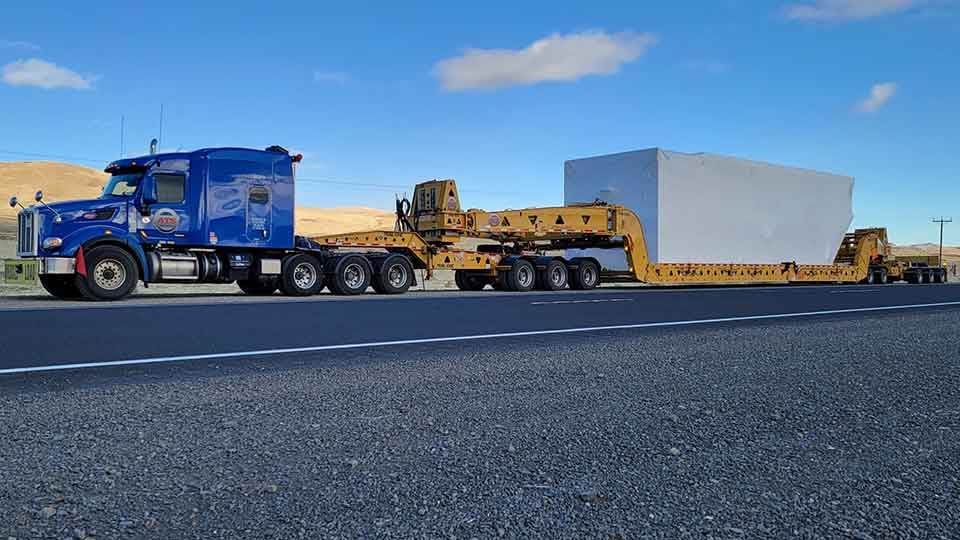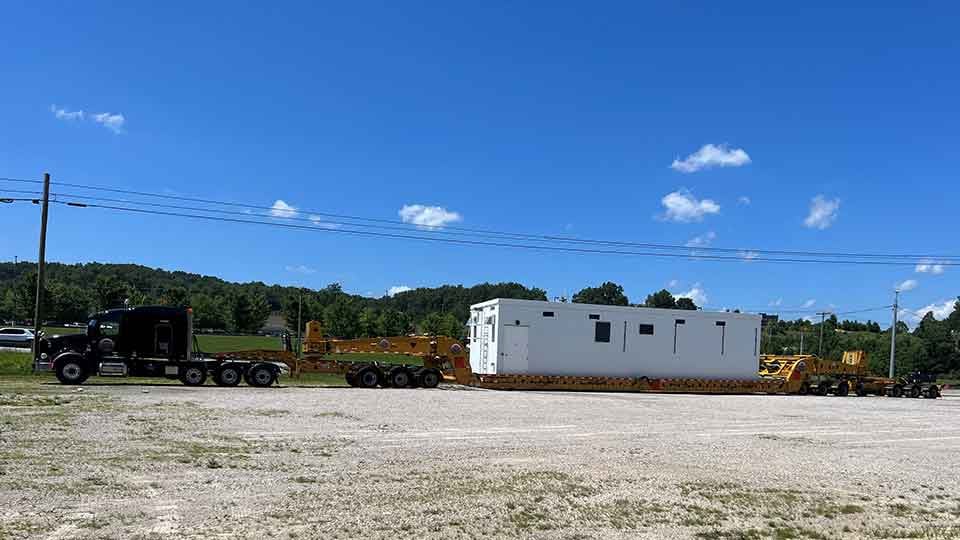
Roads and bridges are engineered to support a specific amount of weight. Exceeding this weight limit can have disastrous consequences, including bridge collapse or permanent road damage.
The only way to safely travel over these roads and bridges is to stay under the maximum allowed weight. This weight is measured per axle.
Think of the axles as the foundation of the load. As a building gets larger, so does its foundation. Just as a larger foundation can support a larger building, more axles can support more weight.
At Anderson Trucking Service (ATS), we use an extensive fleet of multi-axle trailers to haul over-dimensional freight for customers on a daily basis. Safety is our priority, and using the right trailer is the first step in safely moving overweight freight over roads and bridges.
In this article, you’ll learn what information is needed for multi-axle trailer loads, and how a carrier uses that information to select the right vehicle. This information will help you find the right carrier — and the right vehicle — for your over-dimensional freight.
What Types of Freight Require Multi-Axle Trailers?
The equipment that keeps our country running continues to get larger and heavier. This is very apparent when looking at power generation equipment, heating and cooling equipment, mission-critical data centers and their enclosures.
The freight in these markets can greatly exceed the weight and dimensions allowed for over-the-road travel. The only way to safely and legally move this freight is to obey the relevant federal, state, county and local laws and get all necessary permits.
Before obtaining those permits, you’ll want to determine which truck and trailer must be used for transit.
How to Determine the Number of Axles Required for Heavy Haul Shipments
All axles have two kinds of ratings:
- Maximum legal axle weight rating: The amount of weight the axle can support while staying under the legal limit allowed with no permit.
- Maximum permitted axle weight rating: The maximum amount of weight the axle can safely carry. There is no permit or exception to this weight limit.
Using the total weight of the shipment, transportation providers calculate the number of axles required for transport.
These axles are spread over the trailer (where the freight rests) and the tractor (the power unit that pulls the trailer).
- Standard tractors have three axles.
- Heavy haul tractors have four or more axles.
Each additional axle allows the truck to spread weight over more area (expanding its foundation).
Your provider will use the total weight of your freight and legal axle weight regulations, to determine the number of axles required for your freight and how they will be grouped.
Using the Bridge Formula to Determine the Required Number of Axles
The Federal Highway Administration’s Bridge Formula (used to keep commercial trucks from damaging roads and bridges) is:
Here are the variables in this equation:
- W = the maximum weight in pounds that can be carried on a group of two or more axles to the nearest 500 pounds (230 kg).
- L = spacing in feet between the outer axles of any two or more consecutive axles.
- N = number of axles being considered.
This helps calculate federal legal axle weight limitations. Many states will have additional bridge and roadway restrictions. Some jurisdictions may have even lower legal weight laws, based on the strength and age of their infrastructure. Older infrastructure tends to necessitate lower per-axle weight limits.
Axle configuration is part of this formula. Generally, the further apart you place the axles, the more weight they can support. The required distance between axles will be determined by the type of freight and vehicle.
While there is a standard formula to use to figure out axle weight limits, this is not a job for an amateur or inexperienced shipper. Public safety is on the line, in addition to the value of your freight and other vehicles on the road.
Consult with an experienced industry professional who understands your freight, the route and their equipment before moving a heavy permitted load. Not all transportation providers are prepared to handle freight of this size, and you need a partner you can trust before, during and after your shipment.
When vetting transportation providers for your load, ask what type of equipment they have in their fleet. For example, some carriers only have standard vehicles available, which are not suitable for heavy haul freight.
Transporting Heavy Haul Freight With the 13-Axle Perimeter Trailer
One example of a multi-axle trailer used to haul heavy oversize freight, such as data center enclosures, is the 13-axle perimeter trailer. While it isn’t the largest trailer on the market, using it as a case study is one way to learn more about heavy haul freight.
- Freight sits within the frame of the trailer 14 inches off the ground. This lowers the overall height of the load as well as its center of gravity, two key components in moving freight safely from origin to destination.
- The trailer can be expanded from a minimum width of 10 feet, 2 inches up to a maximum width of 20 feet. Cargo up to 17 feet, 6 inches wide can fit inside this frame at its lowest height. The trailer frame can be widened onsite to frame specific items and protect them from in-transit damage.
- The trailer can also be extended to handle a length of up to 70 feet.
- Overall weight capacity is up to 150,000 pounds. This maximum capacity will vary depending on the states you will be traveling through and the dimensions of the shipment.
- Like many large trailers, the 13-axle trailer is rear-axle steerable. The rear axles are powered separately using a remote control steered by an escort following the trailer. This is the only way a vehicle of this size is able to maneuver and make tight turns.

The trailer itself is one part of the equation when it comes to moving heavy haul freight. The planning that goes into using the trailer, as well as the team involved, will also determine the success of the project.
Preparing the Trailer for Heavy Haul Shipments
Heavy haul trailers are not one-size-fits-all solutions. The length and width of the many trailers are adjustable to safely contain freight without any wasted space.
A mechanical computer-aided design (CAD) drawing of the cargo on the trailer showing weight per axle and the overall trailer configurations with all weights and dimensions allows carriers to move crossmembers on site and make sure no axle is over legal limits.
These drawings are also used to adjust the width and length of some trailers. Each jurisdiction will require permits for overweight shipments. Initial CAD drawings are often used to order the appropriate paperwork.
Choosing the Best Trailer for Oversize Freight Shipping
If you wouldn’t skimp on a building foundation (and we really hope you wouldn’t), you also shouldn’t skimp on finding the right trailer for your over-dimensional load.
Using the Bridge Formula and the information specified on your oversize freight permit, will help you find the right trailer for a shipment of any size. Once the trailer is chosen, the next step is to find a team who will work with the driver before, during and after the shipment.
Choosing the right carrier is critical to the success of your heavy haul shipment. The Heavy Haul Carrier Selection Checklist can help you narrow your search to the most qualified carriers for your specific load, no matter how big it might be.




